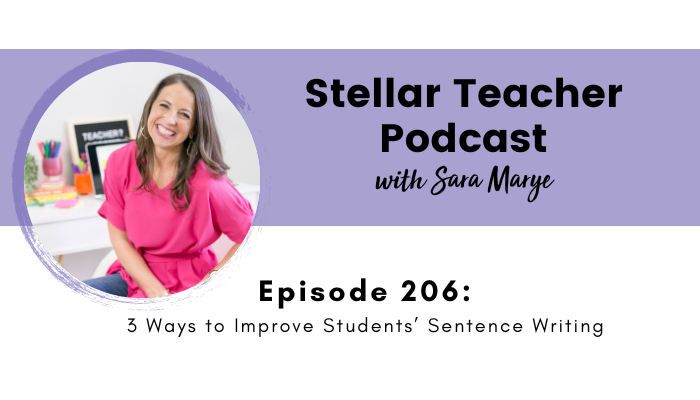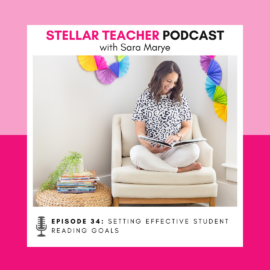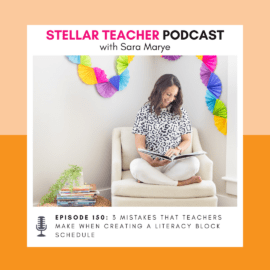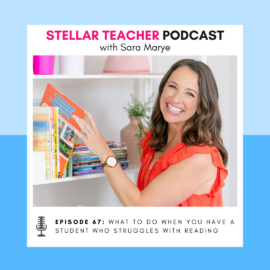
Click play below to hear ways to improve student sentence writing:
A common misconception upper elementary teachers often make with sentence writing is that students don’t need to practice or develop this skill. Since teachers are so focused on the end result of a five-paragraph essay, sentence writing is often ignored or not prioritized. However, that’s not benefiting students and their academic success at all. Instead, this foundational skill needs to be incorporated daily into their literacy block. In today’s episode, I’m sharing 3 ways to improve student sentence writing and why it directly impacts academic success.
Before diving into ways to improve student sentence writing, I provide you with background information on the impact and effect being able to write a complete sentence has on a student’s writing, academic success, and life. This information will transform the way you view sentence writing and begin to make it a priority in your classroom. Each of the 3 ways to prioritize effective sentence writing includes daily and explicit teaching or modeling in order to develop this skill. I also provide you with examples of how to efficiently implement it into your literacy block, along with a simple bonus tip.
Even though practicing sentence writing sounds like a lower elementary skill, it’s actually not. The inability to write a complete sentence or not having the knowledge of sentence structure really impacts a student’s academic success. Incorporating my 3 time-efficient strategies will help improve student sentence writing and eventually make them skilled sentence writers.
In this episode on ways to improve student sentence writing, I share:
- Why focusing on sentence writing is so important, especially with reading comprehension and fluency
- How the inability to write a complete sentence or have the foundation of sentence writing skills impacts a student’s overall academic success
- 3 things to prioritize for effective sentence writing skills
- A bonus tip that incorporates grammar activities that support sentence writing
Resources:
- Sentence Writing Routine Free Sample
- Sign up for my Private Podcast: Confident Writer Systems Series
- Check out the Stellar Literacy Collective Membership
- Check out my Free Literacy Workshop, The Time Crunch Cure: Create a Literacy Block That Fits it All In and Achieves More
- If you’re enjoying this podcast, please leave a review on Apple Podcasts!
Related episodes and blog posts:
- Episode 194, Must-Teach Writing Skills for the Start of School
- Episode 167, Elevate Student Writing With These 4 Revision Strategies
- Episode 166, How Can I Help My Students Become Stronger Paragraph Writers?
- Episode 163, Sentence Deconstruction: What It Is, How It Helps, and Steps to Take To Fit It Into Your Day
- Episode 161, 5 Reasons Why You Need to Spend More Time on Sentence Writing in Upper Elementary
- Episode 139, Practice Sentence Deconstruction [Small Steps to S.O.R. Part 2]
- Episode 101, A Literacy Routine for Building Students’ Sentence Structure Skills
- Sentence-Level Writing: Why Upper Elementary Teachers Need to Prioritize This Skill
Connect with me:
- Join my newsletter
- Shop my TPT store here
- Instagram: @thestellarteachercompany
- Facebook: The Stellar Teacher Company
More About Stellar Teacher Podcast:
Welcome to the Stellar Teacher Podcast! We believe teaching literacy is a skill. It takes a lot of time, practice, and effort to be good at it. This podcast will show you how to level up your literacy instruction and make a massive impact on your students, all while having a little fun!
Your host, Sara Marye, is a literacy specialist passionate about helping elementary teachers around the world pass on their love of reading to their students. She has over a decade of experience working as a classroom teacher and school administrator. Sara has made it her mission to create high-quality, no-fluff resources and lesson ideas that are both meaningful and engaging for young readers.
Each week, Sara and her guests will share their knowledge, tips, and tricks so that you can feel confident in your ability to transform your students into life-long readers.
Tune in on your favorite podcast platform: Apple, Google, Amazon, Spotify, Castbox, and more! If you’re loving this podcast, please rate, review, and follow!
Podcast (stellar-teacher-podcast): Play in new window | Download
Okay, raise your hand if you have students who struggle to write in complete sentences. And right now, I can imagine that most if not all of you have your hands raised right now. And I can also guess that your students struggle with sentence writing probably has a major impact on their academic success, not just with writing, but their inability to write a complete sentence is probably having an impact in all academic areas.
And that’s really because sentence writing is one of those foundational skills, that if we want our students to be successful with any type of writing, or successful, really, in any academic area, or in life, they really have to understand how sentences work. And they have to have the tools to be able to craft their own sentences.
Now, even though sentence writing is an essential skill, it is often ignored an upper elementary or it’s not prioritized. And that’s probably because you guys know you have the push and the pressure for the end of your state test to really get your students to write a five paragraph essay by the end of the year. And if you think about it, if your goal is something massive and big, like a five paragraph essay, who has time for sentence writing?
Well, the answer is you do. You have time to really focus on sentence writing in your upper elementary classroom. And that is because you know, and you understand that your students are never going to experience success with that five paragraph essay, until they master the art of sentence writing. You know how important sentence writing is.
But also, after listening to this podcast episode, you are going to have three time efficient strategies that you can put in place to really help your students become skilled sentence writers, which means you really have time to focus on sentence level writing in your classroom.
Now, before we jump into those strategies, I just want to reiterate why a specific focus on sentence writing is so important. The first reason is, first of all, we know that sentence writing is essential for writing success. I kind of talked about that already. But sentences are at the heart of all writing. If students cannot write a complete sentence, they will have no hope of crafting a coherent paragraph or anything longer. So they have to be able to write sentences.
You know, students have to really understand how words and phrases work together to form a sentence if they’re going to be a decent writer. And if students are able to compose a clear and coherent sentence, that is a sign that they have an understanding of syntax or sentence structure. And that is incredibly important for more than just writing. And that is because having knowledge of sentence structure or syntax also has an impact on students reading comprehension.
I read somewhere once I think it’s a Nancy Hennessey’s Comprehension Blueprint that comprehension begins at the sentence level. And I love that reminder, because if we want our students to understand a text on a much bigger level, they have to be able to understand and comprehend the sentences that they are reading. You know, if they cannot identify the who or the what in a sentence, how are they going to understand you know, what is actually happening in the story and tracking the details of it.
But in upper elementary sentence has become so much more complex than just identifying the who and the what. And so in order to really comprehend the sentences that students are reading, they have to have understanding of things like conjunctions, the different types of conjunctions and how they connect ideas and relationships within a sentence.
Students really need to be able to understand the function of individual words and the role these words play in sentences. They need to be able to read a complex or compound sentence and to be able to pull out the main point and be able to tell you what is actually happening in that sentence. And they can’t do these things unless they have a strong grasp of how sentences work, which is something that they get through explicit writing instruction.
But sentence structure knowledge also has an impact on students reading fluency. You know, if students struggle with fluency, it is possible that they have an issue with phrasing and they don’t have, you know, appropriate phrasing while they’re reading. And one strategy you can do to help students with phrasing is called scooping phrases. And that is where students look at a sentence, they draw lines under a phrase, so they know which words need to be strung together when they’re reading.
But if a student struggles to understand what phrases are, and they can’t, you know, they don’t know which words go together in the sentence, it’s going to be really hard for them to identify them, and then work on their fluency and their phrasing. So in addition to being really incredibly important with writing, having knowledge of sentence structure also impacts reading comprehension and reading fluency.
And so we really want to be intentional about explicitly teaching students sentence structure and giving them practice with sentence writing, and then giving our students opportunities to practice and play at the sentence level. So I have three things that you can do to really prioritize effective sentence writing, and these things will help your students become much better sentence writers.
So the first one is to implement a daily sentence writing routine. And if something is important to turn it into a routine, because creating a routine is probably the easiest way to ensure that you do something daily. So if your students need practice with sentence writing, create a routine that focuses on different sentence writing tasks, do it every single day. And then you can be guaranteed that your students are going to get the practice they need.
Now, I would suggest dedicating anywhere from five to 10 minutes every day to focus just on sentence writing. At a minimum, maybe especially at the start of the year, you want to spend more than that, but at a minimum every day, spend at least five to 10 minutes, just focusing on sentence writing. And I know that might not sound like a ton of time. But if your students just focused on one sentence writing tasks each day, the impact of that small action would add up.
Now we have a sentence writing routine. I’ve talked about it before. And we share this with our members inside the Stellar Literacy Collective. And one of our members shared that after six weeks of using this quick daily routine, her students revising and editing scores increased 15%, which I think is really awesome. Now if you want to check out a free sample of our routine, you can go to stellarteacher.com/sentences and you can grab that.
But really, you can set up this writing routine and so many different ways. You could use it as a warm up to your writing block. So this is the first thing that you do you know, when you start your writing time. You could also incorporate it into your morning routine. So before you even begin your academic day, your students are getting practice with sentence writing. You could really squeeze this in and so many parts in your instructional day.
Now I’m going to share with you the five different activities that we include in our sentence writing routine. And hopefully that will inspire you to either use ours or create your own.
So with our specific routine, each week, students have a photograph that they use to inspire their sentence writing. So on Monday, they look at the photograph, and they are going to expand a sentence using the W questions. So they’re going to start with who, what, when, where and why to build out a sentence.
On Tuesday, they’re going to look at the picture. And they’re going to write four different sentences, a question, a statement, a command and an exclamation. On Wednesday, they’re going to look at three sentences. And they’re going to figure out which one of those sentences is actually a fragment, and then they’re going to correct it to us becomes a complete sentence. On Thursday, they’re going to take two simple sentences and combine them into one. And then on Friday, they unscramble a set of words to create a sentence.
So each day students are really writing maybe just one sentence. But because they are focusing on so many different sentence writing tasks throughout the week, they are really developing a strong foundation of how sentences work. So like I said, there are so many different ways that you could set up a writing routine, a sentence writing routine.
This is just an example of different activities. But I really would encourage you to think about how can I carve out five to 10 minutes every day just to focus on sentence writing. And like I said, if you do that every single day for the entire year, you will be amazed at the progress your students make with their sentence writing.
So the second thing that you can do to really help your students improve their sentence writing skills is to practice sentence deconstruction while reading. Now I did I’ve actually done two episodes on this but last summer I did a whole episode in on this back in episode number 139. So if you want a little bit more information about it, go back and listen to that episode.
But sentence deconstruction is simply identifying a sentence, hopefully from a text that your students have read, and then breaking that sentence apart, and you can deconstruct it and break it apart in a bunch of different ways.
I would first of all suggest making sure that the sentence is visible for your students to see so you’re either writing it on the whiteboard, or showing a slide that has the sentence, and then working with your students to break that sentence apart. Maybe you’re going to identify the different phrases in the sentence, maybe you’re going to remove extra words.
So realizing that when you pull out adjectives and adverbs, you’re still left with a simple sentence, you know, with a simple subject, which is a noun and a simple predicate, which is a verb, which still is a complete sentence. You could also have your students identify any conjunctions in the sentence and explain how the conjunction connects ideas, and figure out what two ideas are connected through this conjunction.
So basically, you want to use a sentence from a text that your students have read, and use it as an opportunity to explain and model some aspect of syntax. And you know, actual sentence writing is really important, which your students are going to get with that sentence right in your team. But we also want to be intentional about showing students, you know, examples of syntax and discussing syntax and sentence structure, with sentences that already exist, you know, giving them a model.
And this is really going to help students strengthen just their understanding of how sentences work, especially if they’re seeing examples of what they’re practicing in their writing in the texts that they are reading. And it’s just going to help bring an overall writing awareness.
So the third thing that you can do is a really fun activity for students. And that is simply just a sentence building activity. And this is where you’re going to have your students build a sentence, one word at a time. And this can be really fun, especially if you want to make it like a silly sentence. Or if you wanted to make it serious, you could always connect it to a topic or something that you are studying in science or social social studies.
But the goal is to have students build a sentence one word at a time. So you’re gonna have them start with the smallest sentence they can make, which means they have to have a noun, and a verb, and more than likely, they have to have an article as well. So maybe their sentence would be the shark sang. We can’t get much more simple than that.
Then you would tell them to add in an adjective. So maybe their sentence would become the pink shark sang. And then we would tell them to add in an adverb, the pink shark sang beautifully, then we tell them to add in a prepositional phrase, under the spotlight, the pink shark sang beautifully. And this activity is great.
First of all, it does not take a ton of time, it does not take a ton of prep and it really helps students understand the role and the function of words, and where they fit in sentences. I think one of the struggle with students and their writing is they don’t understand the different slots or the different spaces within a sentence, where words should go.
So if they understand that, you know, nouns need to come before verbs that can help them in organizing their sentence if they understand that adjectives are going to be connected to nouns adverbs are going to be connected to verbs like that is going to help them understand how to construct a sentence. And if all they’re doing is building a sentence one word at a time, it’s going to be a lot easier for them to understand how to combine words and how to combine phrases into a complete sentence.
If your students struggle, though, with identifying right because if your prompt is add an adverb, add an adjective, add a prepositional phrase, and your students can’t recall that or can’t come up with that on their own. One thing that you could do is you could show students either a poster or a word chart or a slide that has lists of adjectives and adverbs and prepositional phrases that they could choose from as they’re building out their sentence. But again, this is a really simple, quick activity that will help students develop their understanding of sentence structure.
And then just a little bonus tip is to really prioritize grammar activities that involve sentence writing, and not just worksheet activities. And examples would be the three things that I shared in this episode. So put a sentence writing routine in place, do sentence deconstruction and practice sentence building. All three of these are going to help your students understand key grammar concepts that even go beyond sentence structure.
If your students are working on the sentence writing routine, it gives you an opportunity to talk about capitalization and punctuation and subject verb agreement, and all of those grammar concepts that we are so often tempted to teach with a worksheet, but we know that our instruction is going to be so much more effective if students are actually writing. We want to avoid teaching our grammar concepts through worksheets, and really try to incorporate more high impact activities like the ones I’ve mentioned in this episode to teach grammar, especially when we’re focusing on sentence writing.
Okay, so I would love to know which of these activities are you going to try first this next year and can you envision yourself doing all three in your classroom? Hopefully that’s the case.
Now, of course, if you are looking for resources to support you and your students with big humming stronger sentence writers, we would love to have you join us inside the Stellar Literacy Collective. Doors are going to open up in just a few weeks and all of our brand new reading whole group lessons that we’ve created for third, fourth and fifth grade actually have a built in sentence structure slide that will help you deconstruct a sentence from the text your students are reading.
So if you want to naturally weave in conversations about syntax and sentence structure and noun phrases and verb phrases and conjunctions and types of sentences, we already have that ready for you to go. So all you would have to do is read the text and show your students this slide. We also in addition to our new home group lessons, we also have a variety of sentence writing activities as well. Add your name to the waitlist stellarteacher.com/waitlist so that way you are notified when doors open up.
And then don’t forget to tune in this Thursday for another episode in our Stellar Teacher Science of Reading Summer Series. We have just a few Thursday’s left. And this week, I will be sharing a strategy that is going to make it easier for your students to read those big multisyllabic words. You don’t want to miss it. I will see you then, and until then have a stellar week.








Leave a Comment
You must be logged in to post a comment.